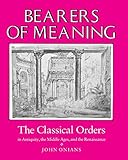Bearers of Meaning : The Classical Orders in Antiquity, the Middle Ages, and the Renaissance / John Onians.
Material type: TextPublisher: Princeton, NJ : Princeton University Press, [2020]Copyright date: ©1990Description: 1 online resource (368 p.)Content type:
TextPublisher: Princeton, NJ : Princeton University Press, [2020]Copyright date: ©1990Description: 1 online resource (368 p.)Content type: - 9780691221953
- Architecture -- Orders
- Architecture, Ancient
- Architecture, Medieval
- Architecture, Renaissance
- ARCHITECTURE / History / General
- Aachen, palace chape
- Aeolic order
- Alessi, Galeazzo
- Aristotle
- Attic columns
- Barbadori family
- Benavides, Marco
- Borgo San Sepolcro
- Bramante, Donato
- Caesar, Julius
- Callimachus
- Cellini, Benvenuto
- Christ
- Cicero
- Composite order
- Corinthian order
- Dante Alighieri
- Dorians
- Doric order
- Egypt
- El Djem (Thysdrus)
- Etruria
- Flavians
- Florence
- Francis I
- Franks
- Genoa
- Gonzaga, Federigo
- Herodotus
- Honorius of Autun
- Leonardo da Vinci
- Manetti, Giannozzo
- Ottomans
- Pergamum
- Plato
- Poliphilus
- anthropomorphism
- architects
- clergy and laity
- craftsmen
- emotions
- encyclopaedias
- etymologies
- exempla
- festivitas
- government
- inscriptions
- letters
- licence
- maniera
- music and architecture
- paintings
- quadratura
- NA2815
- online - DeGruyter
| Item type | Current library | Call number | URL | Status | Notes | Barcode | |
|---|---|---|---|---|---|---|---|
 eBook
eBook
|
Biblioteca "Angelicum" Pont. Univ. S.Tommaso d'Aquino Nuvola online | online - DeGruyter (Browse shelf(Opens below)) | Online access | Not for loan (Accesso limitato) | Accesso per gli utenti autorizzati / Access for authorized users | (dgr)9780691221953 |
Browsing Biblioteca "Angelicum" Pont. Univ. S.Tommaso d'Aquino shelves, Shelving location: Nuvola online Close shelf browser (Hides shelf browser)

|

|

|

|

|

|

|
||
| online - DeGruyter Presidential Primaries and the Dynamics of Public Choice / | online - DeGruyter Constitutional Diplomacy / | online - DeGruyter Gregorian Chant and the Carolingians / | online - DeGruyter Bearers of Meaning : The Classical Orders in Antiquity, the Middle Ages, and the Renaissance / | online - DeGruyter A Literature of Their Own : British Women Novelists from Bronte to Lessing / | online - DeGruyter Germany Divided : From the Wall to Reunification / | online - DeGruyter Colonizing Hawai'i : The Cultural Power of Law / |
Frontmatter -- Contents -- Illustrations -- Acknowledgements -- Introduction -- I Classical Greece -- II The Hellenistic world and the Roman Republic -- III Vitruvius -- IV The Roman Empire -- V Early Christianity -- VI The column in the Christian Middle Ages -- VII The orders in the Christian Middle Ages -- VIII The crisis of architecture: Medieval and Renaissance -- IX The Tuscan Renaissance -- X Alberti -- XI Filarete -- XII Francesco di Giorgio Martini -- XIII Architects and theories in the later fifteenth century -- XIV A new Christian architecture -- XV Francesco Colonna -- XVI Luca Pacioli -- XVII Bramante -- XVIII Raphael -- XIX Serlio -- XX Serlio's Venice: Sansovino, Aretino, Titian, and Vasari -- XXI Sixteenth-century choices -- Notes -- Bibliography -- Index
restricted access online access with authorization star
http://purl.org/coar/access_right/c_16ec
For all those interested in the relationship between ideas and the built environment, John Onians provides a lively illustrated account of the range of meanings that Western culture has assigned to the Classical orders. Onians shows that during the 2,000 years from their first appearance in ancient Greece through their codification in Renaissance Italy, the orders--the columns and capitals known as Doric, Ionic, Corinthian, Tuscan, and Composite--were made to serve expressive purposes, engaging the viewer in a continuing visual dialogue.
Mode of access: Internet via World Wide Web.
In English.
Description based on online resource; title from PDF title page (publisher's Web site, viewed 07. Nov 2022)


